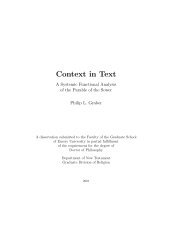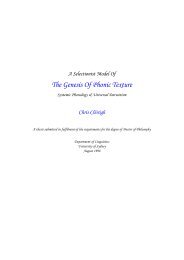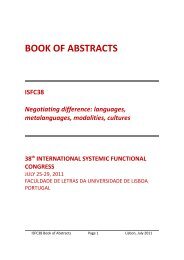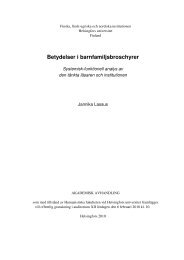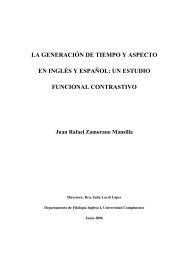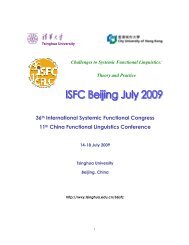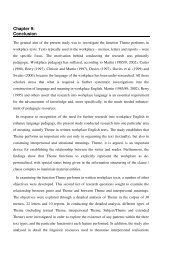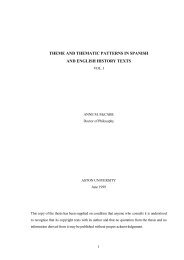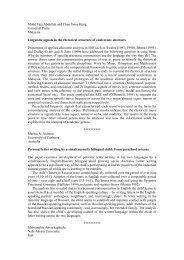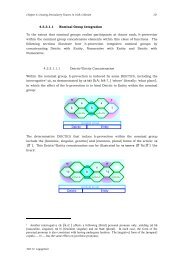the ISFC39 Proceedings - International Systemic-Functional ...
the ISFC39 Proceedings - International Systemic-Functional ...
the ISFC39 Proceedings - International Systemic-Functional ...
You also want an ePaper? Increase the reach of your titles
YUMPU automatically turns print PDFs into web optimized ePapers that Google loves.
Papers from <strong>the</strong> 39th ISFCWho has <strong>the</strong> knowledge if not <strong>the</strong> Primary Knower? - Usingexchange structure analysis to cast light on particular pedagogicpractices in teaching Danish as a Second Language and HistoryAnna-Vera Meidell SigsgaardPhD Fellow, Dept. of Education (DPU), Aarhus University,Tuborgvej 164, DK-2400 Copenhagen NV, Denmarkavm@dpu.dkAbstractThis paper reports on findings from a project researching Danish as a Second Language (DSL). While officialpedagogic discourse (Bernstein, 2000) is available in curriculum guidelines, <strong>the</strong> historically grounded relativeautonomy of schools means that <strong>the</strong> actual pedagogic discourse of DSL varies in terms of teachers’competencies. A deeply rooted progressivist approach to schooling combined with a more recent focus onnational testing correlate with a Ministerial recommendation that DSL be taught embedded in <strong>the</strong> school’s o<strong>the</strong>rsubjects (Undervisningsministeriet, 2005). This paper focuses on <strong>the</strong> pedagogic practices of one case of DSLembedded in a fifth grade History unit, taught in a Danish public school with 85% bilingual students. Exchangestructure analysis (Martin, 1992; Martin & Rose, 2007) makes visible certain patterns of classroom discourse.With focus on <strong>the</strong> K1-move, which according to <strong>the</strong> <strong>the</strong>ory is <strong>the</strong> only obligatory move in a knowledge exchange,analysis of <strong>the</strong> collected data shows, interestingly, that this move is often ambiguous or missing, which raisesquestions of a more general pedagogic nature, conceptualized here by <strong>the</strong> knower code from Legitimation CodeTheory (Maton, 2000, forthcoming).1 Introduction – What Are We Going To Learn Today?Children in a fifth grade class ga<strong>the</strong>r to start a new History topic; as <strong>the</strong>y sit down, <strong>the</strong>y aretalking and joking with each o<strong>the</strong>r and <strong>the</strong> three teachers in <strong>the</strong> room. This school’s fifthgrade is made up of 30 children divided into two teams, sharing five teachers who work ingroups and individually depending on <strong>the</strong> subjects and <strong>the</strong> units being taught. As such, thisclass is very similar to most Danish public school classrooms. What sets it apart is that it is ina school where <strong>the</strong> majority of <strong>the</strong> children are classified as ‘bilingual’ 1 .Evidence of <strong>the</strong> so-called fourth grade slump (Chall, Jacobs, & Baldwin, 1990; Gitz-Johansen, 2006) experienced by many second language students and increasing linguisticdiversity of students’ backgrounds presents challenges to <strong>the</strong> Danish public school and hasled to <strong>the</strong> development <strong>the</strong> relatively new school subject, Danish as a Second Language(DSL) 2 .1.1 DSL in <strong>the</strong> S-School – Background and DataThe S-School, where this data is ga<strong>the</strong>red, is a K-9 public school servicing an area outside ofCopenhagen where <strong>the</strong> majority of <strong>the</strong> population has an ethnic minority background,generally with a fairly low socio-economic status and often referred to as “second generationimmigrants”. Schools like <strong>the</strong> S-School have been highly politicized and discussed in <strong>the</strong>media for <strong>the</strong> past decades, as <strong>the</strong>y and <strong>the</strong> areas <strong>the</strong>y service are often seen as a cause forconcern: <strong>the</strong>y tend to have poor results, many students have trouble while in school, do not1 The Ministry of Educations terms bilingual children as those who speak a language o<strong>the</strong>r than Danish at homeand start learning Danish when exposed to Danish society and public institutions such as day care or school.2 DSL appeared as a recognized school subject with official ministerial guidelines for <strong>the</strong> first time in 1995.9



